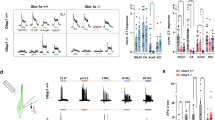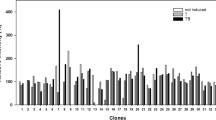Abstract
SEVERAL lines of evidence suggest that both sweet and bitter tastes are transduced via receptors coupled to heterotrimeric guanine-nucleotide-binding proteins (G proteins) (reviewed in refs 1, 2). Gustducin is a taste receptor cell (TRC)-specific G protein that is closely related to the transducins3. Gustducin and rod transducin, which is also expressed in TRCs (ref. 4), have been proposed to couple bitter-responsive receptors to TRC-specific phosphodiesterases to regulate intracellular cyclic nucleotides2–5. Here we investigate gustducin's role in taste transduction by generating and characterizing mice deficient in the gustducin α-subunit (α-gustducin). As predicted, the mutant mice showed reduced behavioural and electrophysiological responses to bitter compounds, whereas they were indistinguishable from wild-type controls in their responses to salty and sour stimuli. Unexpectedly, mutant mice also exhibited reduced behavioural and electrophysiological responses to sweet compounds. Our results suggest that gustducin is a principal mediator of both bitter and sweet signal transduction.
This is a preview of subscription content, access via your institution
Access options
Subscribe to this journal
Receive 51 print issues and online access
$199.00 per year
only $3.90 per issue
Buy this article
- Purchase on Springer Link
- Instant access to full article PDF
Prices may be subject to local taxes which are calculated during checkout
Similar content being viewed by others
References
Kinnamon, S. C. & Cummings, T. A. A. Rev. Physiol. 54, 715–731 (1992).
Margolskee, R. F. Curr. Opin. Neurobiol. 3, 526–531 (1993).
McLaughlin, S. K., McKinnon, P. J. & Margolskee, R. F. Nature 357, 563–569 (1992).
Ruiz-Avila, L. et al. Nature 376, 80–85 (1995).
Kolesnikov, S. S. & Margolskee, R. F. Nature 376, 85–88 (1995).
Zylstra, M. L. E., Sajjadi, F., Subramani, S. & Jaenisch, R. Nature 342, 435–438 (1989).
Mistretta, C. in Smell and Taste in Health and Disease (eds Getchell, T. V., Doty, R. L., Bartoshuk, L. M. & Snow, J. B.) 35–64 (Raven, New York, 1991).
Harder, D. B., Maggio, J. C. & Whitney, G. Chemical Senses 14, 547–564 (1989).
Tinti, J.-M. & Nofre, C. in Sweeteners: Discovery, Molecular Design and Chemoreception (eds Walters, D. E., Orthoefer, F. T. & DuBois, G. E.) 88–99 (Am. Chem. Soc., Washington DC, 1991).
Ninomiya, Y., Mizukoshi, T., Higashi, T., Katsukawa, H. & Funakoshi, M. Brain Res. 302, 305–314 (1984).
Ninomiya, Y. & Funakoshi, M. Comp. Biochem. Physiol. 92A, 371–376 (1989).
Spielman, A. I. et al. Am. J. Physiol. 270, C926–C931 (1996).
Akabas, M. H., Dodd, J. & Al-Awqati, Q. Science 242, 1047–1050 (1988).
Striem, B. J., Pace, U., Zehavi, U., Naim, M. & Lancet, D. Biochem. J. 260, 121–126 (1989).
Striem, B. J., Naim, M. & Lindemann, B. Cell Physiol. Biochem. 1, 46–54 (1991).
Naim, M., Ronen, T., Striem, B. J., Levenson, M. & Zehavi, U. Comp. Biochem. Physiol. 100B, 455–458 (1991).
Tonosaki, K. & Funakoshi, M. Nature 331, 354–356 (1988).
Avenet, P. & Lindemann, B. J. Membr. Biol. 97, 223–240 (1987).
Avenet, P., Hofmann, F. & Lindemann, B. Nature 331, 351–354 (1988).
Naim, M., Seifert, R., Nurnberg, B., Grunbaum, L. & Schultz, G. Biochem. J. 297, 451–454 (1994).
Neer, E. Cell 80, 249–257 (1995) .
Soriano, P., Montgomery, C., Geske, R. & Bradley, A. Cell 64, 693–702 (1991).
Mansour, S. L., Thomas, K. R. & Capecchi, M. R. Nature 336, 348–352 (1988).
Szabo, P. & Mann, J. R. Development 120, 1651–1660 (1994).
Kwee, L. et al. Development 121, 489–503 (1995).
Stewart, C. L. et al. Nature 359, 76–79 (1992).
Laird, P. W. et al. Nucleic Acids Res. 19, 4293 (1991).
Krieg, P. A. & Melton, D. A. Meth. Enzym. 155, 397–415 (1987).
Lugo, D. I., Roberts, J. K. & Pintar, J. E. Molec. Endocr. 3, 1313–1324 (1989).
Gannon, K. S. & Contreras, R. J. Physiol. Behav. 57, 231–239 (1995).
Author information
Authors and Affiliations
Rights and permissions
About this article
Cite this article
Wong, G., Gannon, K. & Margolskee, R. Transduction of bitter and sweet taste by gustducin. Nature 381, 796–800 (1996). https://doi.org/10.1038/381796a0
Received:
Accepted:
Issue Date:
DOI: https://doi.org/10.1038/381796a0
This article is cited by
-
The proton channel OTOP1 is a sensor for the taste of ammonium chloride
Nature Communications (2023)
-
The effect of maternal period nutritional status on oro-sensorial fat perception and taste preference in rats
Molecular and Cellular Biochemistry (2023)
-
Bitter Peptides in Fermented Soybean Foods - A Review
Plant Foods for Human Nutrition (2023)
-
Sensory Systems for Sugar-Induced Cephalic Phase Insulin Release
Current Oral Health Reports (2023)
-
Expression and Functional Role of Olfactory, Taste, and Phototransduction Signal Proteins in β Cells in Islets of Langerhans
Neuroscience and Behavioral Physiology (2022)
Comments
By submitting a comment you agree to abide by our Terms and Community Guidelines. If you find something abusive or that does not comply with our terms or guidelines please flag it as inappropriate.



